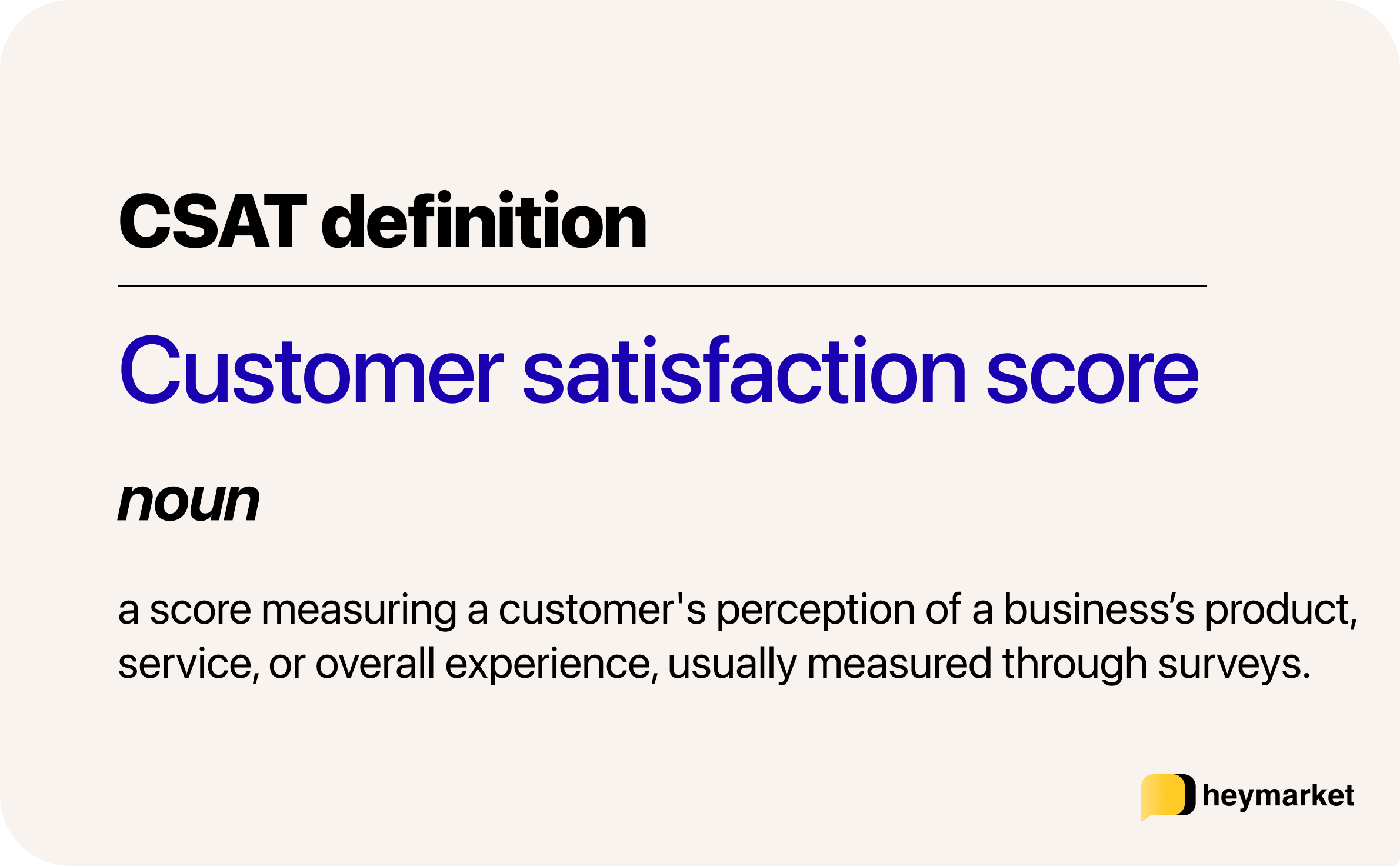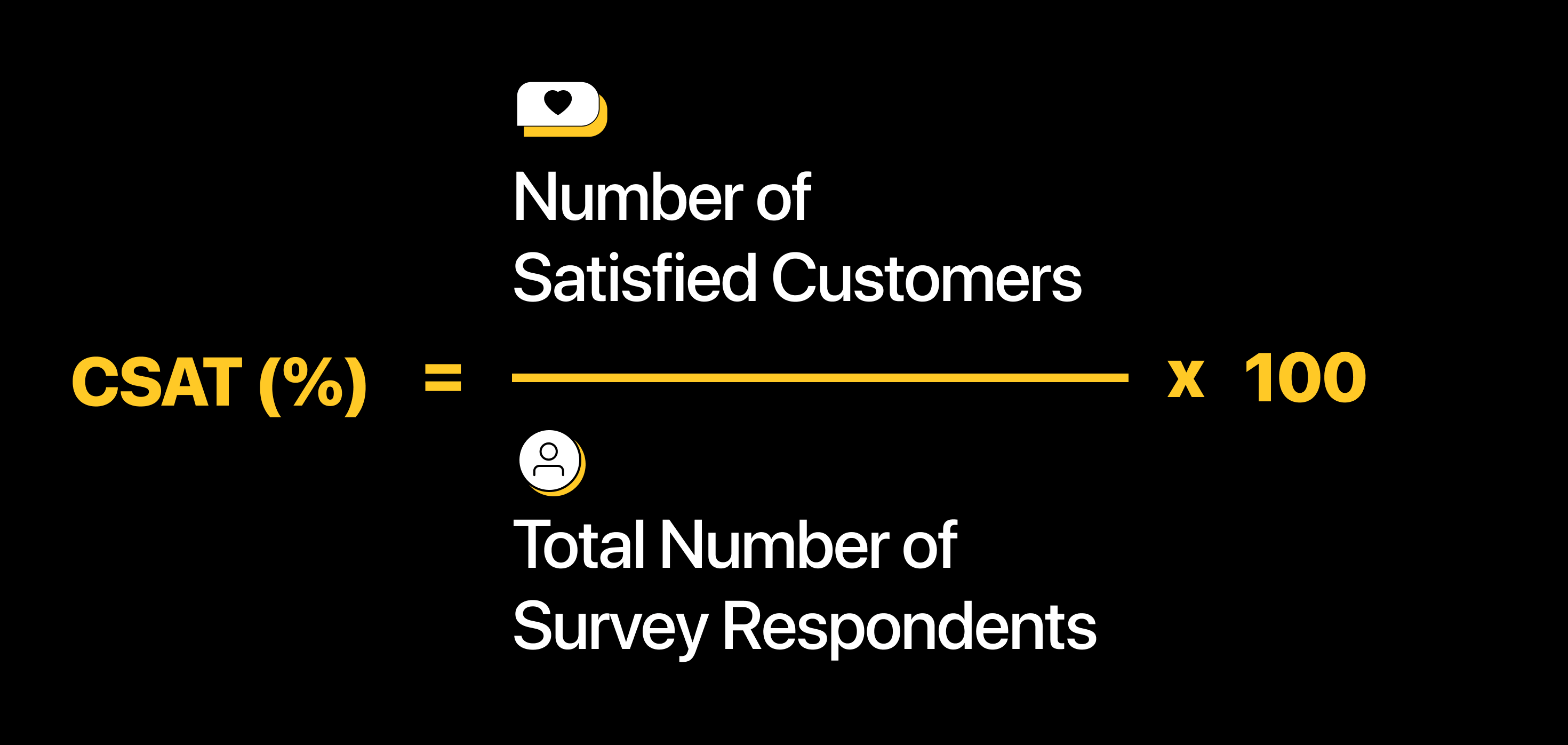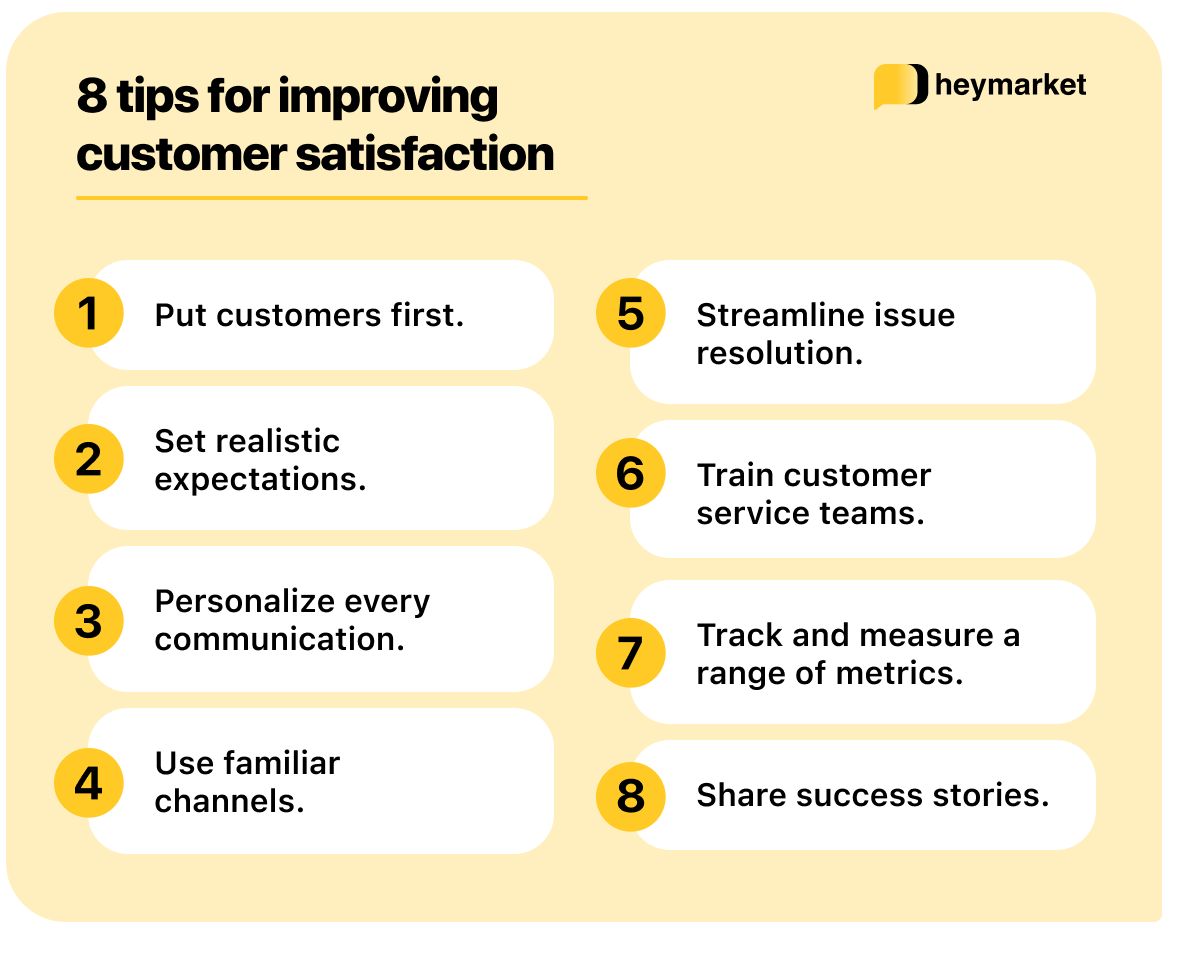Today’s customers have high expectations from the brands they interact with, to the point that their happiness can make or break a business. Brands are responding by focusing on their customers more holistically than before, and those that do so successfully can see 60% more profitability than those that don’t.
One of the first steps to understanding your customers’ experience is by measuring CSAT, or customer satisfaction score. In this post, we’ll explore the meaning of CSAT, how to measure it, and best practices for tracking CSAT and improving your customers’ overall satisfaction.
What is CSAT?
CSAT (customer satisfaction score) measures a customer’s perception of a business’s product, service, or overall experience. Companies most commonly measure CSAT through customer surveys and feedback, which allow businesses to gauge their performance and make data-driven improvements.

A wide range of industries rely on CSAT as a performance metric to gauge customer satisfaction. For instance, in retail, CSAT scores reflect how effective customer service interactions are. In the software industry, CSAT measures users’ satisfaction with a product or service.
Why should you measure CSAT?
Measuring CSAT gives businesses valuable insights into customer sentiment, highlights areas for improvement, and helps identify potential issues that could impact customer loyalty and retention. By monitoring CSAT, businesses can proactively address customer concerns, enhance their offerings, and create a stronger customer experience overall.
CSAT vs. NPS score
CSAT and NPS (Net Promoter Score) are both essential customer satisfaction metrics. While CSAT measures overall satisfaction with a specific experience, NPS assesses the likelihood of customers recommending a product or service, usually on a scale of 1 to 10. These two metrics provide complementary insights into different aspects of customer satisfaction and loyalty, making it beneficial to track both for a comprehensive understanding of your business’s performance.
CSAT and NPS surveys are suited to different situations. CSAT surveys are useful for taking customers’ pulse on specific interactions with your business, for example, product releases or your customer service team’s performance. NPS surveys work well for taking the temperature of your business as a whole.
Read more: When to use a CSAT vs. NPS survey
How do you measure CSAT?
A CSAT score is usually expressed as a percentage, ranging from 0% to 100%. Businesses can calculate CSAT by dividing the number of satisfied customers by the total number of survey respondents and multiplying the result by 100. The formula for calculating CSAT is:

What is a good CSAT score?
While the ideal CSAT score may vary across industries, a score of 80% or above is generally considered good. It’s important to note that your business should establish CSAT benchmarks based on your industry standards and customer expectations.
Here are some example CSAT scores by industry:
- Retail: 75%
- Software: 78%
- Restaurants: 81%
- E-commerce: 80%
Example CSAT survey questions
When designing CSAT surveys, it’s crucial to ask concise and targeted questions to collect actionable feedback. Here are some example CSAT survey questions:
- How satisfied were you with our product/service?
- How would you rate your overall experience with our customer support?
- Did our product/service meet your expectations?
- Would you recommend our company to others based on your experience?
Common channels for measuring CSAT
There are several channels businesses can use to collect CSAT data. Here are some popular ones:
- In-app surveys: Integrated surveys within your application or website.
- Live chat surveys: Collecting feedback during or after a live chat session.
- Email surveys: Sending surveys to customers’ email addresses as a follow-up to an email or phone conversation.
- Text messaging surveys: Leveraging business text messaging to send CSAT surveys to customers, allowing them to respond directly within their existing text messaging thread.
Why CSAT matters
Customer satisfaction matters because happy customers are more likely to remain loyal, make repeat purchases, and recommend your business to others. Satisfied customers tend to spend more over time, resulting in increased revenue and improved bottom-line performance.
By measuring CSAT scores, businesses can understand and improve on the following core KPIs:
Enhance customer loyalty and retention
By measuring and improving CSAT, businesses can foster stronger customer loyalty and retention. Satisfied customers are more likely to become repeat customers and advocate for your brand, resulting in increased customer lifetime value and reduced churn rates.
Retaining satisfied customers has a direct impact on your bottom line: depending on your industry, it can cost five to seven times more to acquire a new customer than to retain a current one.
Improve brand reputation and customer advocacy
A high CSAT score contributes to a positive brand reputation, as satisfied customers are more inclined to share their positive experiences with others. Word-of-mouth recommendations and positive online reviews can significantly influence potential customers: 90% of people are more likely to trust a recommended brand, even if they don’t know the people recommending it. Growing word-of-mouth and online reviews can both drive organic growth and expand your customer base.
Give a competitive advantage
By continuously measuring and improving CSAT, businesses can gain a competitive edge. A higher CSAT score indicates superior customer satisfaction, positioning your business as a preferred choice in the market and differentiating you from competitors.
Pros and cons of CSAT scores
While CSAT is an effective metric for assessing customer satisfaction, it does have limitations. CSAT may not capture the full complexity of customer sentiment and preferences — it is a percentage after all. Because of this, it’s useful to complement CSAT measurements with other metrics, like NPS, to paint a more comprehensive picture of your customers’ experiences.
Here’s a closer look at CSAT’s pros and cons:

Pros of CSAT:
- Provides quantitative data on customer satisfaction
- Allows for targeted improvements based on specific areas of dissatisfaction
- Helps companies benchmark against industry standards
- Supports data-driven decision-making
Cons of CSAT:
- Does not capture the full range of customer sentiment or reflect their overall experience
- Limited to specific points in the customer journey (e.g., after a support interaction)
- Relies on customer survey participation
Best practices for measuring CSAT
Now that you know what CSAT is and how to measure it, here are some tips and best practices for getting the most out of your measurement:
Select the right CSAT survey method
When measuring CSAT, it’s crucial to choose a survey method that your customers are the most likely to engage with and respond to.
Start by considering which channels you use to communicate with customers on, and their response rates on each channel. If, for example, your customers respond faster on live chat than via email, consider including CSAT surveys at the end of a live chat conversation. Sending text messaging surveys can be highly effective, as the familiar channel has a 45% response rate (compared to email’s 6% response rate).
Craft effective survey questions
Crafting effective survey questions is crucial for collecting actionable feedback. Ensure your survey questions are concise, relevant, and focus on specific aspects of the customer experience that impact satisfaction levels.
Analyze CSAT data and iterate
Thoroughly analyze CSAT data to identify trends, patterns, and areas for improvement. Use data visualization techniques to gain insights quickly and interpret the results. Use your data to hone your surveying strategy as well as your customer service.
Tips for improving CSAT
As you collect CSAT scores, here are some tips for using the data to improve your customers’ experience and ultimately increase your CSAT scores:
Put customer focus first
Make customer satisfaction a top priority throughout your organization. Ensure that every employee understands the importance of delivering exceptional customer experiences and empower them to resolve issues promptly. Equip them with the right tools to respond to customers quickly, for example by integrating your platforms so they have all of the relevant customer data on hand for a fast response.
By enabling your teams with customer-focused priorities and tools, you can help them deliver standout service and improve CSAT.
Set realistic expectations
Be transparent with your customers about your products, services, and delivery timelines. Clearly communicate what customers can expect, manage their expectations effectively, and strive to exceed those expectations whenever possible. With clear and realistic expectations, customers will be more likely to give you positive feedback.
Personalize at every step
Tailor your customer interactions and communication to make them feel valued and understood. You can create a highly personalized experience by centralizing your team’s access to customer data and keeping clear logs of customer history and interactions. Lean on your CRM and customer data to recommend solutions to each customer’s specific needs. Use custom fields in your communications to automatically customize all of your interactions, including CSAT surveys.
Use customers’ preferred communication channels
Provide multiple channels for customers to reach out and seek support. In addition to traditional channels like phone and email, leverage modern communication channels such as business text messaging, live chat, and social media to offer convenient and timely assistance. Use a shared inbox to see all of your customers’ incoming messages from different text, social, and chat channels so you can respond immediately, providing excellent service on the channels customers use daily.
Streamline the issue resolution processes
Focus on resolving customer issues quickly and efficiently. Implement streamlined processes, empower customer service agents with the necessary tools and information, and establish clear escalation paths to address complex or escalated cases promptly.
Train and empower customer service teams
Your customer service team is the face of your customers’ experience. Invest in comprehensive training programs for your teams. Equip them with the skills, knowledge, and resources necessary to handle customer inquiries effectively and provide exceptional support.
Continuously improve
Use CSAT scores as a benchmark to drive continuous improvement efforts. Regularly assess your performance, identify trends or patterns in customer feedback, and implement changes to address recurring issues or enhance the customer experience.
Measure a range of metrics
In addition to CSAT, consider tracking other relevant metrics such as NPS, customer effort score (CES), and first contact resolution rate (FCR). A holistic view of customer satisfaction will provide a more comprehensive understanding of their experiences.
Share customer success stories
Celebrate and communicate CSAT success stories internally and externally. Share positive customer feedback, testimonials, and case studies to showcase your commitment to customer satisfaction and build trust with potential customers.
By implementing these best practices, businesses can create a customer-centric environment, drive customer satisfaction, and ultimately improve CSAT scores. Remember to constantly monitor, analyze, and improve your strategy to enhance CSAT over time.
Understanding customer satisfaction to improve their experience
By effectively measuring and acting upon customer feedback, businesses can enhance customer loyalty, boost brand reputation, and gain a competitive advantage. And by leaning on accessible channels like text messaging for customer service, businesses can provide personalized and efficient support, leading to improved CSAT scores. As customer expectations continue to evolve, businesses must adapt and prioritize customer satisfaction so both their customers and their brands can thrive.





